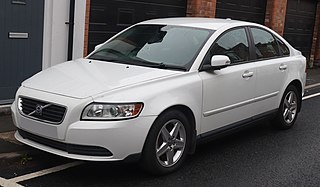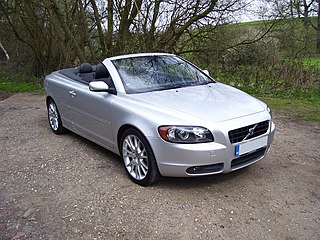
Volvo Cars is a Swedish multinational manufacturer of luxury vehicles headquartered in Torslanda, Gothenburg. The company manufactures SUVs, station wagons, and sedans. The company's main marketing arguments are safety and its Swedish heritage and design.

The Volvo S60 series is a compact executive car manufactured and marketed by Volvo since 2000.

The Volvo V50 is the station wagon version of the Volvo S40 small family car first unveiled at the 2003 Bologna Motor Show, both assembled at Ghent, Belgium. Sharing the Volvo P1 platform with the European Ford Focus and the Mazda 3, the V50 featured interior "theatre" lighting, a floating center stack and "Volvo Intelligent Vehicle Architecture".

The Volvo S80 is an executive car produced by the Swedish manufacturer Volvo Cars from 1998 to 2016 across two generations. It took the place of the rear-wheel-drive S90 as Volvo's flagship sedan.

The Volvo XC60 is a compact luxury crossover SUV manufactured and marketed by Swedish automaker Volvo Cars since 2008.

The Volvo S40 is a series of subcompact executive cars marketed and produced by the Swedish manufacturer Volvo Cars from 1995 to 2012, offered as a more mainstream alternative to the compact executive Volvo S60 to compete in a lower pricing bracket. The S40 was more or less positioned against premium-leaning small family cars like the Volkswagen Jetta as well as some mass-market large family cars.
The Volvo P2 platform is a global full-size unibody automobile platform developed and produced by Volvo. It is designed for single wheelbases and is adaptable to front- or all wheel drive configurations. It was developed by the automaker before its 1999 acquisition by Ford Motor Company, and debuted with the 1998 Volvo S80.

The Volvo V70 is an executive car manufactured and marketed by Volvo Cars from 1996 to 2016 across three generations. The name V70 combines the letter V, standing for versatility, and 70, denoting relative platform size.

The Volvo S70 is a compact executive car produced by Volvo Cars from 1996 to 2000. The S70 was essentially a facelifted 850 saloon. The S70 was replaced with the Volvo S60.

The Volvo S90 is an executive sedan manufactured and marketed by Swedish automaker Volvo Cars since 2016. Its estate variant is called the Volvo V90.

The Volvo C70 is a two-door, four-passenger sport compact manufactured and marketed by Volvo Cars from 1996 to 2013 across two generations.
The Aisin AW AF33 is a 5-speed automatic transaxle developed and manufactured in Anjo, Japan by Aisin AW, a division of Aisin. It is designed to be used in transverse engine configurations in both FWD and AWD configurations.

The Volvo ECC was an executive luxury concept car built by Volvo in 1992. It was a design exercise in using recycled material and hybrid technology. It was powered by a hybrid electric and gas turbine engine. Many of its lines and general styling were used as inspiration for the first generation Volvo S80. The ECC set a new design language for future Volvo models from the S80 onwards, the most obvious styling feature being the stepped waistline, which was inspired by the similar feature on the 200 Series, whilst retaining some of the angular elements from the 700/900 ranges.

The Volvo Modular Engine is a family of straight-four, straight-five, and straight-six automobile piston engines that was produced by Volvo Cars in Skövde, Sweden from 1990 until 2016. All engines feature an aluminum engine block and aluminum cylinder head, forged steel connecting rods, aluminum pistons and double overhead camshafts.

Whiplash Protection System (WHIPS) is a system to protect against automotive whiplash injuries introduced by Volvo in 1998. It was launched when the Volvo S80 was released for the 1999 model year and has since been part of the standard equipment of all new Volvo cars.
Side Impact Protection System (SIPS) is a passive safety system in an automobile to protect against injury in a side collision, developed by Volvo Cars.

The Volvo V90 is a mid-size luxury wagon manufactured and marketed by Swedish automaker Volvo Cars since 2016. Two months after the introduction of the sedan model, the Volvo S90, the V90 was revealed at the Geneva Motor Show in March 2016.

The Volvo 850 is a compact executive car that was produced by the Swedish manufacturer Volvo Cars from 1991 until 1996. Designed by Jan Wilsgaard, the car was introduced in a saloon body style; an estate style was introduced in 1993.

The Volvo Engine Architecture (VEA) is a family of straight-three and straight-four automobile petrol and diesel engines produced by Volvo Cars in Skövde, Sweden, since 2013, Zhangjiakou, China since 2016 and Tanjung Malim, Malaysia since 2022 by Proton. Volvo markets all engines under the Drive–E designation, while Geely groups the three-cylinder variants with its other engines under the G-power name. These engines are some of the few ever put into production as twincharged engines, in the company of the Lancia Delta Integrale and concept Jaguar CX-75.

The Volvo R marque represents the high-performance division of cars produced by Volvo. The R marque refers to an unknown adjective, since Volvo markets R-designated vehicles as being the most performance-oriented trim level. The first vehicle in the Volvo R marque lineup, the Volvo 850 R, was introduced in 1995, followed by the Volvo S70 R and Volvo V70 R in 1998. A related performance trim line, Volvo R-Design, was launched for 2008. Volvo's high-performance vehicles are now developed by their Polestar division, although most Volvo models are offered in an R-Design trim level.






















